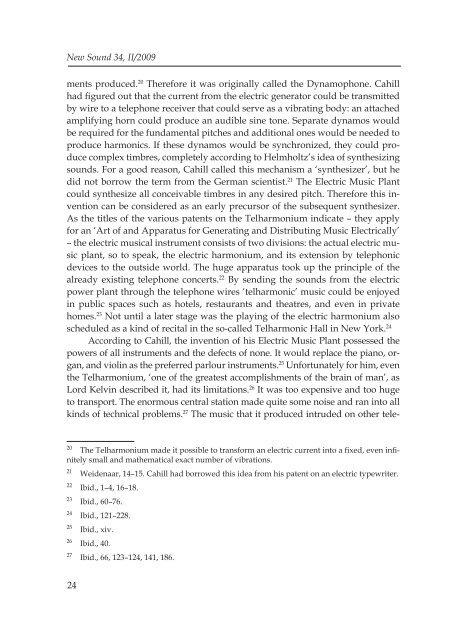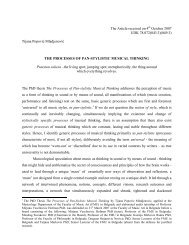John Heymans1 FROM HELMHOLTZ'S SENSATIONS ... - New Sound
John Heymans1 FROM HELMHOLTZ'S SENSATIONS ... - New Sound
John Heymans1 FROM HELMHOLTZ'S SENSATIONS ... - New Sound
You also want an ePaper? Increase the reach of your titles
YUMPU automatically turns print PDFs into web optimized ePapers that Google loves.
<strong>New</strong> <strong>Sound</strong> 34, II/2009<br />
ments produced. 20 Therefore it was originally called the Dynamophone. Cahill<br />
had fi gured out that the current from the electric generator could be transmitted<br />
by wire to a telephone receiver that could serve as a vibrating body: an attached<br />
amplifying horn could produce an audible sine tone. Separate dynamos would<br />
be required for the fundamental pitches and additional ones would be needed to<br />
produce harmonics. If these dynamos would be synchronized, they could produce<br />
complex timbres, completely according to Helmholtz’s idea of synthesizing<br />
sounds. For a good reason, Cahill called this mechanism a ‘synthesizer’, but he<br />
did not borrow the term from the German scientist. 21 The Electric Music Plant<br />
could synthesize all conceivable timbres in any desired pitch. Therefore this invention<br />
can be considered as an early precursor of the subsequent synthesizer.<br />
As the titles of the various patents on the Telharmonium indicate – they apply<br />
for an ‘Art of and Apparatus for Generating and Distributing Music Electrically’<br />
– the electric musical instrument consists of two divisions: the actual electric music<br />
plant, so to speak, the electric harmonium, and its extension by telephonic<br />
devices to the outside world. The huge apparatus took up the principle of the<br />
already existing telephone concerts. 22 By sending the sounds from the electric<br />
power plant through the telephone wires ‘telharmonic’ music could be enjoyed<br />
in public spaces such as hotels, restaurants and theatres, and even in private<br />
homes. 23 Not until a later stage was the playing of the electric harmonium also<br />
scheduled as a kind of recital in the so-called Telharmonic Hall in <strong>New</strong> York. 24<br />
According to Cahill, the invention of his Electric Music Plant possessed the<br />
powers of all instruments and the defects of none. It would replace the piano, organ,<br />
and violin as the preferred parlour instruments. 25 Unfortunately for him, even<br />
the Telharmonium, ‘one of the greatest accomplishments of the brain of man’, as<br />
Lord Kelvin described it, had its limitations. 26 It was too expensive and too huge<br />
to transport. The enormous central station made quite some noise and ran into all<br />
kinds of technical problems. 27 The music that it produced intruded on other tele-<br />
20 The Telharmonium made it possible to transform an electric current into a fi xed, even infi -<br />
nitely small and mathematical exact number of vibrations.<br />
21 Weidenaar, 14–15. Cahill had borrowed this idea from his patent on an electric typewriter.<br />
22 Ibid., 1–4, 16–18.<br />
23 Ibid., 60–76.<br />
24 Ibid., 121–228.<br />
25 Ibid., xiv.<br />
26 Ibid., 40.<br />
27 Ibid., 66, 123–124, 141, 186.<br />
24



